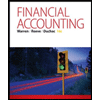
(a)
Liquidity ratio measures the short-term capacity of a company to pay its maturing obligations and to meet unanticipated requirements for cash. Liquidity ratios are
Solvency ratio
Solvency ratio measures the capacity of a company to sustain over a long period of time. Solvency ratios are debt to assets ratio, time interest earned ratio, debt to equity ratio, and more.
To Calculate: The working capital and current ratio of Company H and Company HD.
(a)
Answer to Problem 10.4EYCT
Calculate working capital of Company H as shown below:
Hence, working capital of Company H is $215 million.
Calculate working capital of Company HD as shown below:
Hence, working capital of HD is $2,076 million.
Calculate Current ratio of Company H as shown below:
Hence, current ratio of Company H is 1.23:1.
Calculate Current ratio of Company HD as shown below:
Hence, current ratio of Company HD is 1.73:1.
Explanation of Solution
Working capital is calculated by deducting current liabilities from current assets. Hence, working capital of Company H is $215 million, and working capital of HD is $2,076 million. Current ratio is calculated by dividing current assets with current liabilities. Hence, current ratio of Company H is 1.23:1 and current ratio of Company HD is 1.73:1.
To Discuss: The relative liquidity of company H and HD.
Explanation of Solution
Computation of current ratio of the Company H is 1.23: 1 which is lesser than the Company HD is 1.73: 1. Hence, Company HD current ratio is 50% greater than the Company H current ratio.
(b)
To Compute: The debt to asset ratio and Times interest earned ratio for Company H and Company HD.
(b)
Answer to Problem 10.4EYCT
Calculate debt to asset ratio for Company H as shown below:
Therefore, Company H, debt to assets ratio is 85%.
Calculate debt to asset ratio for Company HD as shown below:
Therefore, Company HD, debt to assets ratio is 35%.
Calculate the times interest earned ratio for the Company H as shown below:
Therefore, Company H, times interest earned ratio is –3.4 times.
Calculate the times interest earned ratio for the Company HD as shown below:
Therefore, Company HD, times interest earned ratio is 72.7 times.
Explanation of Solution
Debt to assets ratio is calculated by dividing total liabilities with total assets and multiplying it with 100. Total liabilities are calculated by deducting total shareholders’ equity from total assets. Therefore, Company H, debt to assets ratio is 85% and Company HD, debt to assets ratio is 35%. Times interest earned ratio is calculated by dividing Income before interest expense and income taxes with interest expense. Income before interest expense and income taxes is calculated by adding net income, interest expense and income taxes. Therefore, Company H, times interest earned ratio is –3.4 times and Company HD, times interest earned ratio is 72.7 times.
To Discuss: The relative solvency of Company H and Company HD.
Explanation of Solution
From the calculation of debt to assets ratio, it is noted that for Company H, it is 85% greater than the Company HD, which is 35%. The higher percentage of debt to assets ratio shows that the Incorporation is at more risk to meet its maturing debts. Hence, Company HD significantly better to meet its obligations comparing to Company H.
The times interest earned ratio identifies a company’s ability to meet interest payments. From the computation of times interest earned ratio, it is found that, Company H’s times interest earned ratio is –3.4 times, which is lesser than Company H, which is 72.7 times. It indicates that Corporation HD has more ability to meet its interest payments than Company H.
(c)
To Compute: The return on assets and profit margin of Company H and Company HD.
(c)
Answer to Problem 10.4EYCT
Calculate return on assets ratio of Company H as shown below:
Hence, return on assets of Company H is –5.7%.
Calculate return on assets ratio of Company HD as shown below:
Hence, return on assets of Company H is 13.1%.
Calculate profit margin of Company H as shown below:
Hence, profit margin of Company H is –2.7%.
Calculate profit margin of Company HD as shown below:
Hence, profit margin of Company H is 5.3%.
Explanation of Solution
Return on assets is calculated by dividing net income by average total assets. Average total assets is calculated by adding opening total assets and ending total assets and then divided by 2. Hence, return on assets of Company H is –5.7% and return on assets of Company H is 13.1%. Profit margin is calculated by dividing net income by net sales and then multiplying with 100. Hence, profit margin of Company H is –2.7% and profit margin of Company H is 5.3%.
To Discuss: The relativity profitability of Company H and Company HD.
Explanation of Solution
Company H’s return on assets is –5.7%, which is lesser than the company HD, which is 13.11%, and Company H’s profit margin is –2.7%, which is lesser than the Company HD, which is 5.3%. The higher percentage of profit margin would get more net income. Therefore, Company HD gets more net income comparing with Company H.
(d)
To Discuss: The debt to assets ratio before and after lease obligations of Company HD.
(d)
Answer to Problem 10.4EYCT
Calculate debt to asset ratio for Company HD before lease obligations, as shown below:
Therefore, Company HD, debt to assets ratio before lease obligations is 35%.
Calculate debt to asset ratio for Company HD after lease obligations as shown below:
Therefore, Company HD, debt to assets ratio after lease obligations is 45%.
Explanation of Solution
Debt to assets ratio is calculated by dividing total liabilities with total assets, and then multiplying with 100. Total liabilities are calculated by deducting total shareholders’ equity from total assets. Therefore, Company H’s debt to assets ratio is 85%, and Company HD’s debt to assets ratio after lease obligations is 45%.
To Discuss: The implications of operating lease obligations.
Explanation of Solution
Company HD’s debt to asset ratio is 10% (45% – 35%) increased after operating lease obligations. Though it recommends that support on debt is actually higher than by the
Want to see more full solutions like this?
Chapter 10 Solutions
Financial Accounting 8th Edition
- I have assignment this 3 Question please Solve It for mearrow_forwardPharoah Street Inc. makes unfinished bookcases that it sells for $59. Production costs are $38 variable and $10 fixed. Because it has unused capacity, Pharoah Street is considering finishing the bookcases and selling them for $73. Variable finishing costs are expected to be $6 per unit with no increase in fixed costs. Prepare an analysis on a per unit basis showing whether Pharoah Street should sell unfinished or finished bookcases. (Enter negative amounts using either a negative sign preceding the number e.g. -45 or parentheses e.g. (45).) Sell Sales price per unit $ $ Cost per unit Variable Fixed Total Process Further Net Income Increase (Decrease) $ Net income per unit $ $ $ The bookcasesarrow_forwardPlease Provide Solution Of this Accounting Question Need Answer For All Questionsarrow_forward
- These transactions took place for Blossom Co. 2024 May 1 Received a $3,000, 12-month, 4% note in exchange for an outstanding account receivable from R. Stoney. Accrued interest revenue on the R. Stoney note. Dec. 31 2025 May 1 Received principal plus interest on the R. Stoney note. (No interest has been accrued since December 31, 2024.) Record the transactions in the general journal. The company does not make entries to accrue interest except at December 31. (List all debit entries before credit entries. Credit account titles are automatically indented when amount is entered. Do not indent manually. Record journal entries in the order presented in the problem. If no entry is required, select "No Entry" for the account titles and enter O for the amount in the relevant debit OR credit box. Entering zero in ALL boxes will result in the question being marked incorrect.) Date Account Titles and Explanation Debit Creditarrow_forwardOriole Co. has the following transactions related to notes receivable during the last 2 months of the year. The company does not make entries to accrue interest except at December 31. Nov. 1 Loaned $54,600 cash to C. Bohr on a 12-month, 8% note. Dec. 11 Sold goods to K. R. Pine, Inc., receiving a $1,800, 90-day, 7% note. Received a $14,400, 180-day, 6% note to settle an open account from A. Murdock. 16 31 Accrued interest revenue on all notes receivable. Journalize the transactions for Oriole Co. (Omit cost of goods sold entries.) (List all debit entries before credit entries. Credit account titles are automatically indented when amount is entered. Do not indent manually. Record journal entries in the order presented in the problem. Use 360 days for calculation. If no entry is required, select "No Entry" for the account titles and enter O for the amount in the relevant debit OR credit box. Entering zero in ALL boxes will result in the question being marked incorrect.) Date Account…arrow_forwardHello tutor please given general accounting question answer do fast and properly explain all answerarrow_forward
 Managerial Accounting: The Cornerstone of Busines...AccountingISBN:9781337115773Author:Maryanne M. Mowen, Don R. Hansen, Dan L. HeitgerPublisher:Cengage Learning
Managerial Accounting: The Cornerstone of Busines...AccountingISBN:9781337115773Author:Maryanne M. Mowen, Don R. Hansen, Dan L. HeitgerPublisher:Cengage Learning Financial Accounting: The Impact on Decision Make...AccountingISBN:9781305654174Author:Gary A. Porter, Curtis L. NortonPublisher:Cengage Learning
Financial Accounting: The Impact on Decision Make...AccountingISBN:9781305654174Author:Gary A. Porter, Curtis L. NortonPublisher:Cengage Learning Financial AccountingAccountingISBN:9781337272124Author:Carl Warren, James M. Reeve, Jonathan DuchacPublisher:Cengage LearningPrinciples of Accounting Volume 1AccountingISBN:9781947172685Author:OpenStaxPublisher:OpenStax College
Financial AccountingAccountingISBN:9781337272124Author:Carl Warren, James M. Reeve, Jonathan DuchacPublisher:Cengage LearningPrinciples of Accounting Volume 1AccountingISBN:9781947172685Author:OpenStaxPublisher:OpenStax College Financial AccountingAccountingISBN:9781305088436Author:Carl Warren, Jim Reeve, Jonathan DuchacPublisher:Cengage Learning
Financial AccountingAccountingISBN:9781305088436Author:Carl Warren, Jim Reeve, Jonathan DuchacPublisher:Cengage Learning





